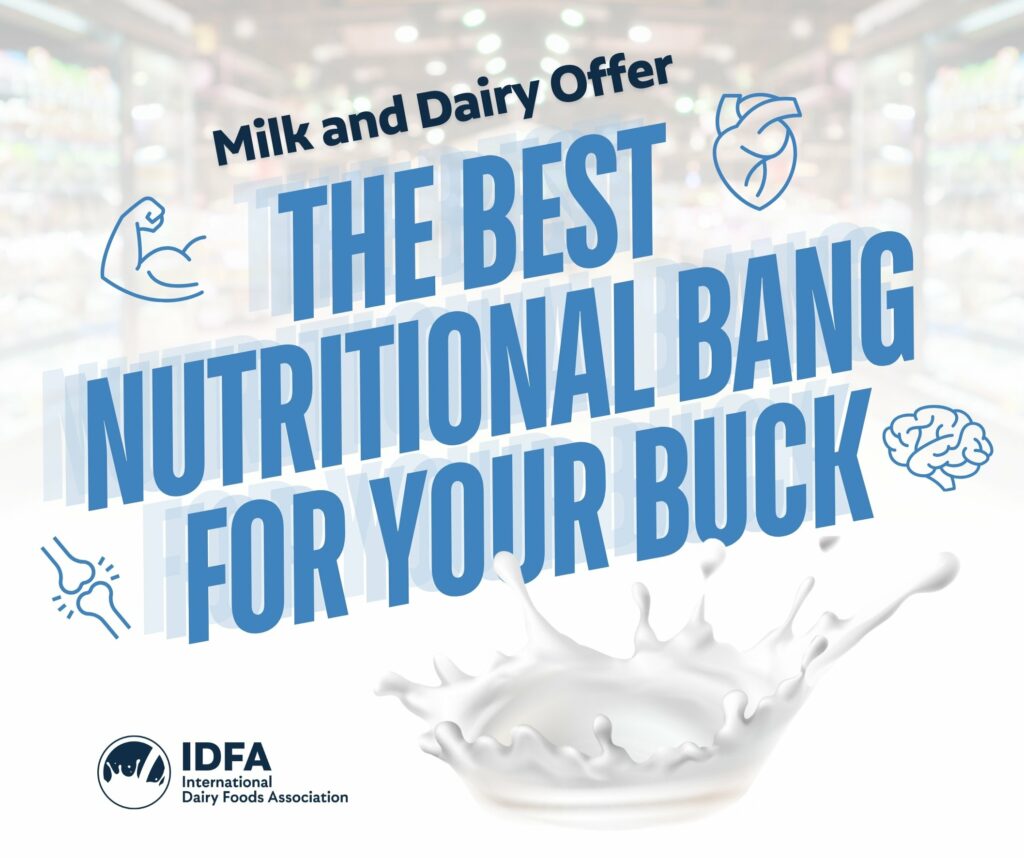By Michelle A. Matto, MPH, RDN, associate vice president, regulatory affairs and nutrition, IDFA
In today’s world, where the cost of living continues to rise, finding affordable yet nutritious food options is paramount, especially for low-income families. A new analysis from the International Dairy Foods Association demonstrates that no other food product provides the same nutritional bang-for-your-buck as do dairy products like milk, cheese, and yogurt. These dairy products not only offer a comprehensive range of vitamins and minerals but also play a crucial role in promoting overall health and combating diet-related chronic diseases—all at an affordable price!
Nutritional Superstars: Milk, Cheese, and Yogurt
Milk is often hailed as a nutritional superfood, and for good reason. A single serving of milk packs 13 essential nutrients, including calcium, vitamin D, and potassium, which are critical for maintaining healthy immune function, hydration, bone health, and reducing the risk of type 2 diabetes and cardiovascular disease. For just 20 cents per serving, milk provides significant levels of three of the four nutrients of public concern in the U.S. Dietary Guidelines for Americans: calcium, vitamin D, and potassium. Many of these nutrients are also present when the milk is converted to cheese and yogurt.
Here’s a snapshot of the nutritional benefits per serving of milk:
- Calcium: 25% of the daily value (DV)
- Protein: 16% of the DV
- Vitamin D: 15% of the DV
- Potassium: 10% of the Dietary Reference Intake*
- Phosphorus: 20% of the DV
- Vitamin A: 15% of the DV
- Riboflavin: 30% of the DV
- Niacin: 15% of the DV
- Pantothenic Acid: 20% of the DV
- Cobalamin (B12): 50% of the DV
- Iodine: 60% of the DV
- Selenium: 10% of the DV
- Zinc: 10% of the DV
Comparing Nutritional Value Across Foods
When comparing the nutrient content of 20 cents worth of milk, cheese, and yogurt to other nutritious foods like broccoli, romaine lettuce, blueberries, apples, and chicken, dairy products consistently provide higher levels of these essential nutrients.
For example, 20 cents of milk offers more calcium, potassium, and vitamin D compared to these other foods, making it a more affordable and comprehensive source of these nutrients, which make up three of the four dietary components of public health concern as highlighted by the Dietary Guidelines for Americans (DGA).
Affordable Nutrition for Low-Income Families
For low-income Americans, accessing nutritious food that fit within a tight budget can be challenging. Dairy products stand out as cost-effective solutions that do not compromise on nutritional quality. By incorporating milk, cheese, and yogurt—including lactose-free and low-lactose options—into their diets, families can ensure they are meeting their nutritional needs without breaking the bank. This accessibility is crucial for supporting the health and well-being of low-income communities, where diet-related chronic diseases are more prevalent.
Policy Implications: Promoting Dairy for Better Health
Policymakers should consider the significant nutritional benefits and affordability of dairy products when designing programs to combat diet-related chronic diseases and hunger. By promoting the inclusion of milk, cheese, and yogurt in the upcoming Dietary Guidelines for Americans report and in federal nutrition assistance programs like SNAP and the National School Lunch Program, policymakers can help ensure that all Americans have access to nutritious and affordable food options.
IDFA advocates for the recognition of dairy products as vital components of a healthy diet. Given their nutrient density and cost-effectiveness, dairy products are uniquely positioned to help address public health concerns and improve the nutritional status of Americans across all income levels.
For more information about dairy’s essential nutrients and health outcomes associated with milk, cheese and yogurt, visit IDFA.org/DairyNourishes.
* In 2019, the National Academies of Sciences, Engineering, and Medicine updated the Dietary Reference Intake for potassium. FDA rulemaking is needed to codify this new level as a Daily Value.
IDFA Staff Expert

Michelle Albee Matto, MPH, RDN
Vice President, Regulatory Affairs and Nutrition


